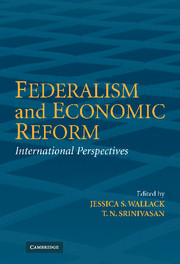Book contents
- Frontmatter
- Contents
- List of Contributors
- Acknowledgments
- 1 Analyzing Federalism: Stylized Models and the Political Economy Reality
- 2 Federalism in Argentina and the Reforms of the 1990s
- 3 Australia: Central Fiscal Dominance, Collaborative Federalism, and Economic Reform
- 4 The Brazilian Federation: Facts, Challenges, and Perspectives
- 5 Changing with the Times: Success, Failure, and Inertia in Canadian Federal Arrangements, 1945–2002
- 6 Fiscal Federalism and Economic Reform in China
- 7 Indian Federalism, Economic Reform, and Globalization
- 8 Mexico's Decentralization at a Crossroads
- 9 Transfer Dependence and Regional Disparities in Nigerian Federalism
- 10 Conclusions and Lessons for Further Study
- Index
- References
5 - Changing with the Times: Success, Failure, and Inertia in Canadian Federal Arrangements, 1945–2002
Published online by Cambridge University Press: 25 July 2009
- Frontmatter
- Contents
- List of Contributors
- Acknowledgments
- 1 Analyzing Federalism: Stylized Models and the Political Economy Reality
- 2 Federalism in Argentina and the Reforms of the 1990s
- 3 Australia: Central Fiscal Dominance, Collaborative Federalism, and Economic Reform
- 4 The Brazilian Federation: Facts, Challenges, and Perspectives
- 5 Changing with the Times: Success, Failure, and Inertia in Canadian Federal Arrangements, 1945–2002
- 6 Fiscal Federalism and Economic Reform in China
- 7 Indian Federalism, Economic Reform, and Globalization
- 8 Mexico's Decentralization at a Crossroads
- 9 Transfer Dependence and Regional Disparities in Nigerian Federalism
- 10 Conclusions and Lessons for Further Study
- Index
- References
Summary
Canada is one of the oldest and, from most perspectives, one of the most successful federal countries in the world. But success has not come easily. Over the 135 years of its existence, Canada has changed in many ways. As the decades rolled by, its territory expanded greatly, the number of provinces (and territories) included in the union grew, its degree of political independence from Britain increased, and, from 1976 to 1985 and from 1994 to 2003, a political party whose explicit objective is separation of one of its provinces gained control of a major province while at the same time Canada's degree of economic dependence on the United States rose to new levels. These and other major changes in the nature of both the country and its environment have required equally major changes in the institutions of Canadian federalism. The union continues to endure, but not without a good deal of effort and not without continuing pressures and strains.
We examine three aspects of Canada's federal arrangements over the past half century. The marked change that has taken place in the sharing of the personal income tax between the federal and the provincial governments is a success story: Successful changes were gradually made over time to accommodate new economic and political circumstances. The unsuccessful attempt to amend the Constitution Act of 1982 to satisfy the demands of Québec, the majority francophone province in Canada, was a failure in spite of great political effort.
- Type
- Chapter
- Information
- Federalism and Economic ReformInternational Perspectives, pp. 189 - 248Publisher: Cambridge University PressPrint publication year: 2006
References
- 13
- Cited by



